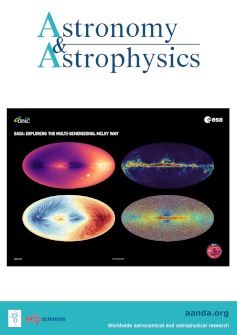Time evolution of o-H2D+, N2D+, and N2H+ during the high-mass star formation process
IF 5.4
2区 物理与天体物理
Q1 ASTRONOMY & ASTROPHYSICS
引用次数: 0
Abstract
Context. Deuterium fractionation is a well-established evolutionary tracer in low-mass star formation, but its applicability to the high-mass regime remains an open question. In this context, the abundances and ratios of different deuterated species have often been proposed as reliable evolutionary indicators for different stages of the high-mass star formation process.Aims. In this study, we investigate the role of N2H+ and key deuterated molecules (o-H2D+ and N2D+) as tracers of the different stages of the high-mass star formation process. We assess whether their abundance ratios can serve as reliable evolutionary indicators.Methods. We conducted APEX observations of o-H2D+ (110–111), N2H+ (4−3), and N2D+ (3−2) in a sample of 40 high-mass clumps at different evolutionary stages, selected from the ATLASGAL survey. Molecular column densities and abundances relative to H2, X, were derived through spectral line modelling, both under local thermodynamic equilibrium (LTE) and non-LTE conditions.Results. The o-H2D+ column densities show the smallest deviation from LTE conditions when derived under non-LTE assumptions. In contrast, N2H+ shows the largest discrepancy between the column densities derived from LTE and non-LTE. In all the cases discussed, we found that X(o-H2D+) decreases more significantly with each respective evolutionary stage than in the case of X(N2D+); whereas X(N2H+) increases slightly. Therefore, the validity of the X(o-H2D+)/X(N2D+) ratio as a reliable evolutionary indicator, recently proposed as a promising tracer of the different evolutionary stages, was not observed for this sample. While the deuteration fraction derived from N2D+ and N2H+ clearly decreases with clump evolution, the interpretation of this trend is complex, given the different distribution of the two tracers.Conclusions. Our results suggest that a careful consideration of the observational biases and beam-dilution effects are crucial for an accurate interpretation of the evolution of the deuteration process during the high-mass star formation process.大质量恒星形成过程中o-H2D+、N2D+和N2H+的时间演化
上下文。氘分馏在低质量恒星形成过程中是一种成熟的演化示踪剂,但其在高质量恒星形成过程中的适用性仍是一个悬而未决的问题。在这种背景下,不同氘化物质的丰度和比率经常被提出作为高质量恒星形成过程不同阶段的可靠进化指标。在这项研究中,我们研究了N2H+和关键的氘化分子(o-H2D+和N2D+)作为大质量恒星形成过程不同阶段的示踪剂的作用。我们评估了它们的丰度比是否可以作为可靠的进化指标。我们从ATLASGAL调查中选择了40个处于不同进化阶段的高质量团块样本,对o-H2D+(110-111)、N2H+(4 - 3)和N2D+(3 - 2)进行了APEX观测。在局部热力学平衡(LTE)和非LTE条件下,通过谱线模型推导了分子柱密度和相对于H2, X的丰度。当在非LTE假设下推导时,o-H2D+柱密度与LTE条件的偏差最小。相比之下,N2H+显示出LTE和非LTE得出的柱密度之间的最大差异。在所有讨论的情况下,我们发现X(o-H2D+)在每个各自的进化阶段都比X(N2D+)减少得更明显;而X(N2H+)则略有增加。因此,X(o-H2D+)/X(N2D+)比率作为一个可靠的进化指标的有效性,最近被认为是不同进化阶段的有希望的示踪剂,在这个样本中没有观察到。虽然N2D+和N2H+的氘化分数随着团块的演化而明显减少,但考虑到两种示踪剂的不同分布,对这一趋势的解释很复杂。我们的研究结果表明,仔细考虑观测偏差和光束稀释效应对于准确解释大质量恒星形成过程中氘化过程的演变至关重要。
本文章由计算机程序翻译,如有差异,请以英文原文为准。
求助全文
约1分钟内获得全文
求助全文
来源期刊

Astronomy & Astrophysics
地学天文-天文与天体物理
CiteScore
10.20
自引率
27.70%
发文量
2105
审稿时长
1-2 weeks
期刊介绍:
Astronomy & Astrophysics is an international Journal that publishes papers on all aspects of astronomy and astrophysics (theoretical, observational, and instrumental) independently of the techniques used to obtain the results.
 求助内容:
求助内容: 应助结果提醒方式:
应助结果提醒方式:


